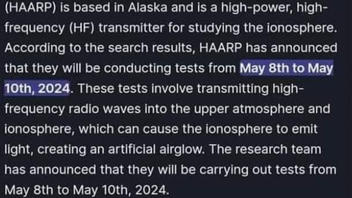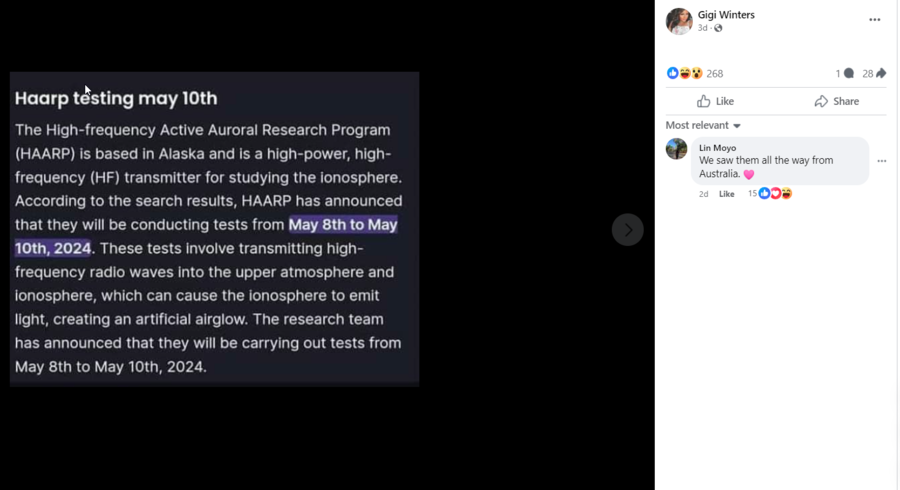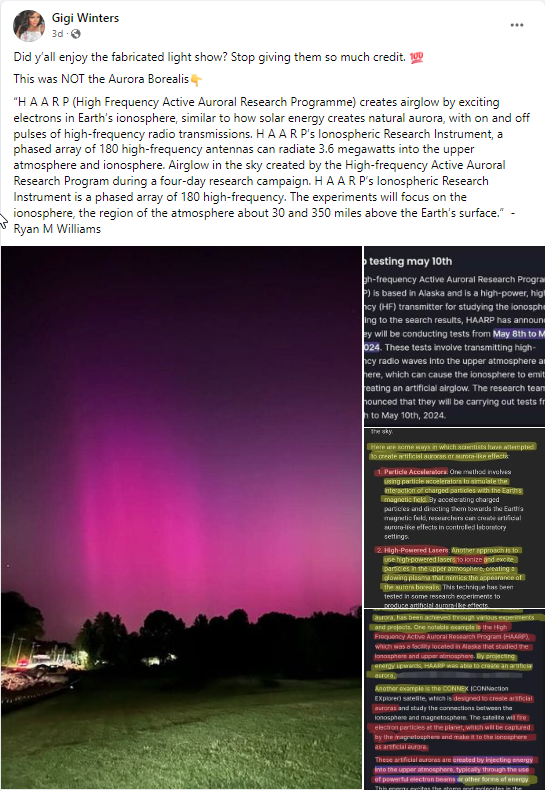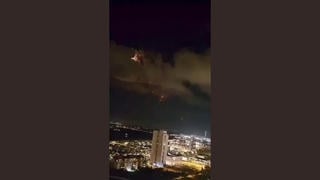
Was an epic display of the northern lights in early May 2024 caused by testing at HAARP (the High-frequency Active Auroral Research Program) in Alaska? No, that's not true: There's no connection between the research program's experiments and the geomagnetic storms that overlapped them. According to a press release from the University of Alaska Fairbanks, where the program is based, the timing was "purely coincidental" as the tests had been scheduled about a month and a half earlier.
The claim appeared in a post on Facebook by Gigi Winters on May 11, 2024. The post's graphic said:
Haarp testing may 10th
The High-frequency Active Auroral Research Program (HAARP) is based in Alaska and is a high-power, high-frequency (HF) transmitter for studying the ionosphere. According to the search results, HAARP has announced that they will be conducting tests from May 8th to May 10th, 2024. These tests involve transmitting high-frequency radio waves into the upper atmosphere and ionosphere, which can cause the ionosphere to emit light, creating an artificial airglow. The research team has announced that they will be carrying out tests from May 8th to May 10th, 2024.
This is what the post looked like on Facebook at the time of writing:
(Source: Facebook screenshot taken on Tue May 14 15:20:03 2024 UTC)
The graphic above was one of four slides in the social media. The post's caption said:
Did y'all enjoy the fabricated light show? Stop giving them so much credit.This was NOT the Aurora Borealis'H A A R P (High Frequency Active Auroral Research Programme) creates airglow by exciting electrons in Earth's ionosphere, similar to how solar energy creates natural aurora, with on and off pulses of high-frequency radio transmissions. H A A R P's Ionospheric Research Instrument, a phased array of 180 high-frequency antennas can radiate 3.6 megawatts into the upper atmosphere and ionosphere. Airglow in the sky created by the High-frequency Active Auroral Research Program during a four-day research campaign. H A A R P's Ionospheric Research Instrument is a phased array of 180 high-frequency. The experiments will focus on the ionosphere, the region of the atmosphere about 30 and 350 miles above the Earth's surface.' - Ryan M Williams
This is what the complete post looked like on Facebook at the time of writing:
(Source: Facebook screenshot taken on Tue May 14 20:48:27 2024 UTC)
High-frequency Active Auroral Research Program
The High-frequency Active Auroral Research Program (HAARP) did indeed operate a scientific campaign between May 8 and May 10, 2024. However, HAARP Director Jessica Matthews dismissed the social media claim that suggested the program was responsible for the celestial light show. In a May 13, 2024, press release, she said:
The HAARP scientific experiments were in no way linked to the solar storm or high auroral activity seen around the globe.
A Space Weather FAQ page on the University of Alaska Fairbanks website, also dated May 13, 2024, answered the question of the potential connection between the coinciding geomagnetic storm and HAARP. It said there was none:
The amazing aurora activity over the weekend seen across the globe was produced solely by a severe geomagnetic storm that was produced by our sun. The sun's activity has been well monitored and the storm's activity was reported multiple times over the weekend by NOAA's Space Weather Prediction Center. NOAA predicted the storm and has been preparing scientists for the event.
The press release added:
The May HAARP campaign was scheduled about a month and a half before the geomagnetic storm. The timing was purely coincidental; geomagnetic storms are unpredictable, with lead times before a solar event is detected from Earth measured in minutes, not months.
National Oceanic and Atmospheric Administration
Lt. Bryan Brasher, project manager for the Space Weather Prediction Center at the National Oceanic And Atmospheric Administration, told Lead Stories in a May 14, 2024, phone interview that the HAARP testing and the global spectacle of the northern lights was a coincidence.
Additionally, Brasher said scientists witnessed massive solar flares on the sun's surface between May 7 and May 8, 2024, which resulted in the geomagnetic storm and aurora borealis that peaked a few days later.
While the HAARP transmitter can produce a very dim version of the northern lights for scientists to observe in and around Alaska, Brasher said it simply isn't able to match the power of the sun, especially not during this particularly powerful solar storm:
We are estimating, what we call hemisphere power input, meaning the total energy being put into the Earth's magnetosphere at one point, is greater than 300 gigawatts, which is ... 8,000 times differential or like four or five orders of magnitude.
Brasher added:
The power output of what we're talking about here [HAARP] isn't great enough. And secondly, I don't see how it'd be physically possible to have a station using over the horizon radar based only in Alaska, that could possibly cause a global effect.
This edition of the northern lights was visible over large sections of the Northern Hemisphere during the overnight hours of May 10, 2024, and was even seen by some observers south of the equator. The Washington Post reported on May 14, 2024:
Whereas auroras are typically confined near Earth's polar regions, social media posts showed Friday night's display was seen in all 50 states as well as rare places like Puerto Rico, the Bahamas, Italy, Austria, Mexico and India. In the Southern Hemisphere, people photographed them in Chile, Argentina, New Zealand and Australia.
Read more
At the time this was written, PolitiFact had reviewed the same claim.
Other Lead Stories articles on claims regarding HAARP are here.














